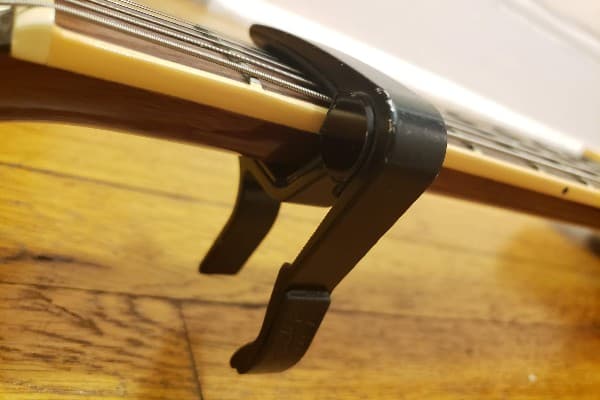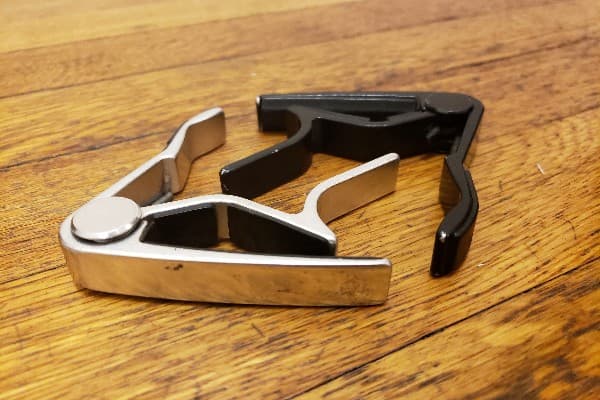While there are plenty of cheap capos around, you need something decent for recording. Presently, I use the Dunlop 83CB or 83CS. Because I have both, so I grab whichever one I can find.
However, the 83CB and 83CS are the exact same capo, just with different finishes. Now, I’ve been using these two capos for years. At this point, it’s unlikely that I’ll use any other.
Background
Surprisingly, I don’t have any particular story behind my ownership of the 83CB or 83CS.
Quite simply, I needed a capo – I think I had misplaced my old elastic capo. And I decided that rather than another cheapo one, to spend a little money on something decent.
So, I went into PMT in Birmingham, and the 83CB was their cheapest trigger capo.
At some point later, likely due to misplacing it or forgetting it on the way to the studio or a gig or something, I needed to buy another one. But, on this occasion, they only had the 83CS. But, later I found the original 83CB.
At one point, I had two 83CSs and the 83CB. But, now I have one of each.
In use
Immediately after clipping the 83CB to the Encore electro-acoustic I was using at the time, it felt like I was playing a completely different instrument.
Although Dunlop’s website lists the 83CB/83CS as an acoustic capo, I’ve used it on everything…

Although I don’t have photographic or videographic evidence right now, I’m certain I’ve tried it with bass and ukulele too, just for lols, to see if it’d work.
It did.
In each instance where I’ve tried using it, the Dunlop 83CB/83CS performed as I needed it.
To this end, I’m not entirely sure why different capos might be required for different instruments. Particularly for electric and acoustic guitars.

In any case, the 83CB/83CS is incredibly easy to use. Simply squeeze the trigger of the capo with your index finger and thumb to open it. Then place it on the desired fret.
It covers all strings, holding them down securely. However, on occasion, I might need to center the spring, just to apply sufficient pressure. But, I’ve had both of these for well over a decade now, so that’s OK.
Additionally, it should be noted that while it worked on the classical Gibson C-1, it wasn’t ideal. It was slipping a little. So, if you listen closely to the completed Dawn and Tim, it might sound a little off. Which is why it’s carefully low in the mix.
Dunlop 83CB/83CS: conclusion
| Cost: significantly cheaper than some of the fancier trigger capos on the marker | Cost: however, they cost three or so times more than an elastic capo |
| Versatility: you can use it on almost anything | Spring: the end of the spring will occasionally need centering |
| Construction: its simple design makes for sturdy construction – if you break this,you tried really hard |
To conclude, I’ve been using the Dunlop 83CB and 83CS for around a decade or so. And I’m a firm believer that if something ain’t broke, don’t try and fix it.
So, if you’re looking for a decent capo, that won’t break the bank, and will last as long as you don’t lose it (seriously, I lost both of mine just by virtue of having them out, writing this post) saving the pennies for an 83CB is a good shout.
If you found this helpful, subscribe on the right hand side of this page. You’ll be notified of new posts on Thursdays, inspiring you going into the weekend.
And share why you found it helpful. Because it helps us, and others!
Share your own light audio recording thoughts and experiences! There’s a Facebook group, a Subreddit, Twitter and Instagram.
Also, on LinkedIn, you can see the business-brain of Light Audio Recording at work.
Additionally, feel free to shoot me a coffee!
Finally, this is a music project, so we’re on Spotify – the playlist below starts with the most recent release and works backwards. So, feel free to follow us!
